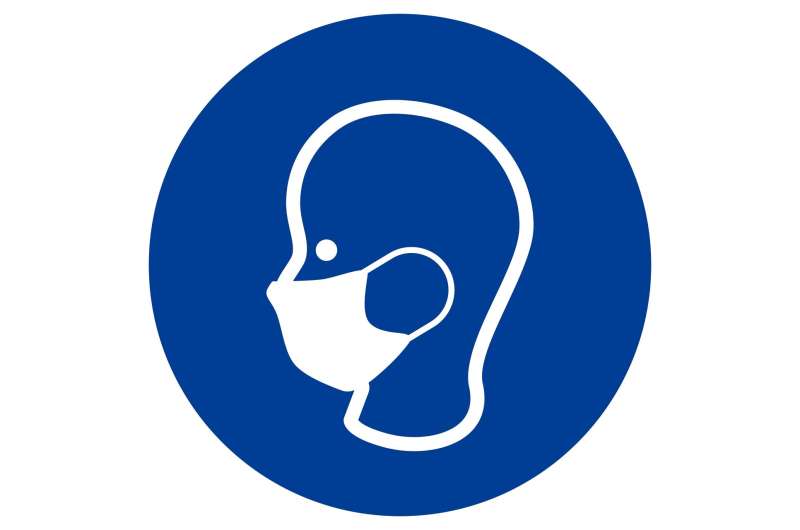Study shows why conservatives may reject some pandemic measures

A new study may reveal part of the reason why conservatives are more likely than liberals to reject some COVID-19 health measures: They see boundaries as restrictions.
Liberals were more likely to see some of the measures used in the pandemic—such as social distancing rules and plexiglass separators in restaurants and stores—as providing guidance, rather than restrictions.
"There seems to be a fundamental ideological difference in how people view boundaries," said Selin Malkoc, co-author of the study and professor of marketing at The Ohio State University's Fisher College of Business.
"Conservatives are more likely than liberals to see boundaries as a way to restrict what they can do."
And the finding doesn't apply only to politically charged topics: The study found ideological differences in how people viewed other types of boundaries, including a row of traffic cones and a three-sectioned plate.
But the findings also showed a way to describe boundaries that make them more appealing to conservatives.
The study was led by Jianna Jin, a doctoral student in marketing at Ohio State. Russell Fazio, professor of psychology, was also a co-author. The research was published recently in the Journal of Experimental Psychology: General.
In a series of four studies—three with online samples and one with college undergraduates—participants responded to various types of boundaries, indicating whether they saw them as guidance or restrictions.
In one of the studies, participants were shown a photo of a social distancing sign indicating where people should stand to stay 6 feet apart at a restaurant. Participants rated the sign on a scale of 1-7 in which 1 was "The sign seems to guide where customers can or cannot stand" and 7 was the "The sign seems to restrict where customers can or cannot stand."
The other studies were similar, but asked about partitioned time slots to pick up groceries (to "structure" when they can or cannot pick up their items versus "restrict"), a row of traffic cones (that "guide" where people can or cannot go versus "restrict"), or a three-sectioned plate (to "control" your meal portions versus "restrict").
In all four studies, people who indicated their political orientation as conservative were more likely to see these boundaries as restrictions rather than guidance—even in the studies on their views concerning the plate partitions and traffic cones, which were not political.
When they began the study, the researchers weren't sure that conservatives would be more likely to see boundaries as restrictions, Jin said. Other research suggests conservatives have a stronger need for structure and order and thus could prefer an organized environment. So they could have seen boundaries as being more positive.
"For example, if you think about a set of traffic cones arranged in a row, they can be viewed as both 'restricting' and 'structuring' the traffic flow," Jin said. "It could be that conservatives would appreciate the structure that boundaries provide."
A follow-up study investigated further how conservatives felt about structure.
In that study, a different group of participants gave their reactions to a set of 16 words as quickly as possible, rating them on a 7-point scale from "very negative" to "very positive."
The researchers were interested in four target words—structure, guidance, guidelines and control—chosen to convey a sense of orderliness and predictability that is associated with structure.
As the researchers expected, findings showed that conservative participants were more favorable to the structure-related words.
So what would happen if messages about COVID-19 health measures emphasized how boundaries provided structure? Another study investigated that question.
Online participants completed the same social distancing sign task from the previous study: They were shown a photo of a social distancing sign indicating where people should stand to stay 6 feet apart at a restaurant.
But in this case, some participants read an additional line that said "arrow stickers on the floor are placed to structure the customer flow." Others read a line that said the arrows restricted customer flow or saw no additional line of text.
Results showed that conservative participants had a more positive attitude toward the sign when they were told it provided structure versus when they were told it restricted customers or when they received no message about the sign.
People who identified as highly liberal actually showed less favorability toward the sign when it said it structured customer flow. This might be because of the political climate surrounding the social distancing signs, Malkoc said.
"They may have thought the structure framing of the message suggested too lax enforcement of social distancing," she said.
The results show that conservatives and liberals inherently differ in how they think of the same boundary, Malkoc said.
"But the words used to explain these boundaries can help focus attention on how they provide structure—and thus appeal more to conservatives," she said.
More information: Jianna Jin et al, For whom do boundaries become restrictions? The role of political orientation., Journal of Experimental Psychology: General (2023). DOI: 10.1037/xge0001361
Journal information: Journal of Experimental Psychology
Provided by The Ohio State University
Studies examine different understandings, varieties of diversity
No comments:
Post a Comment